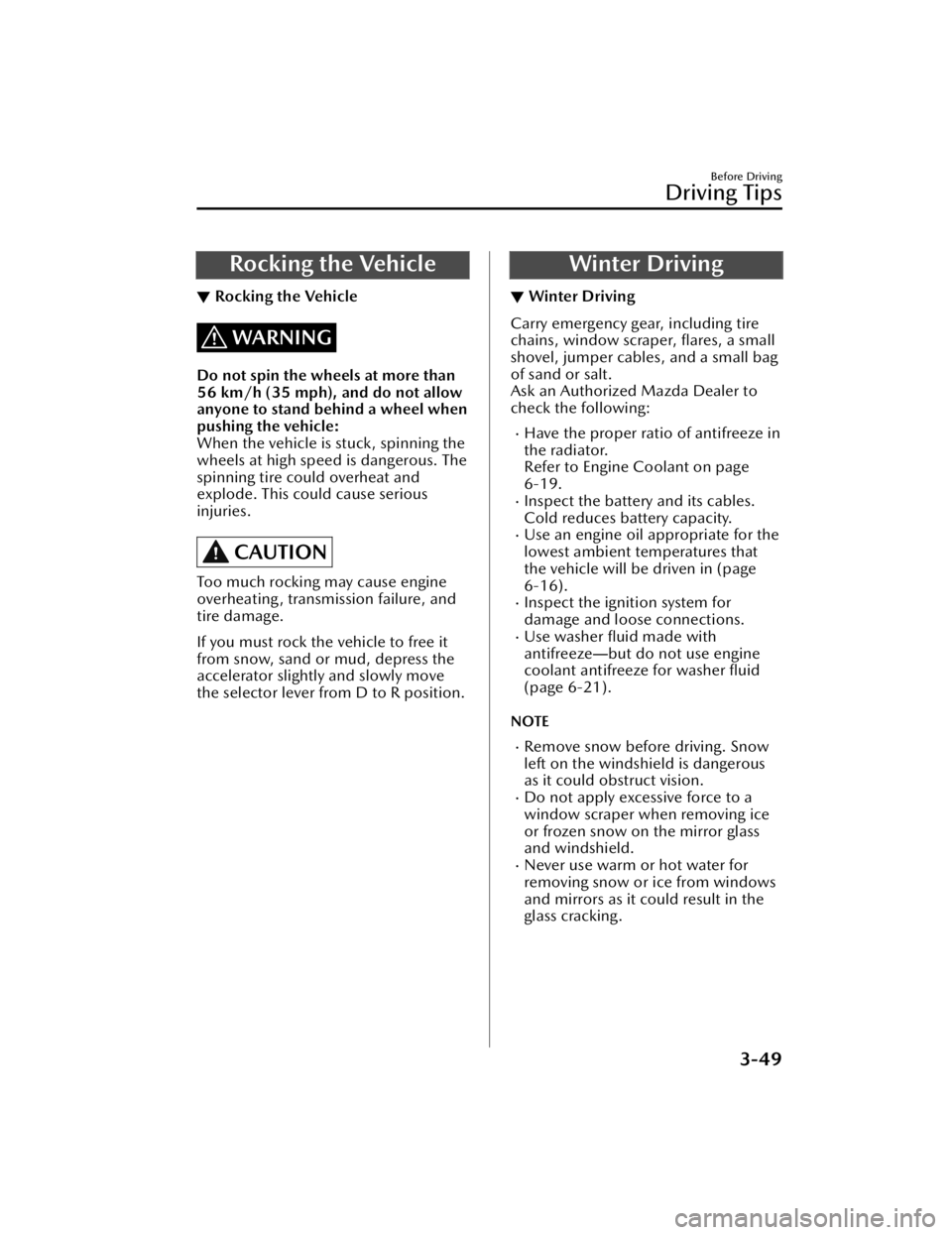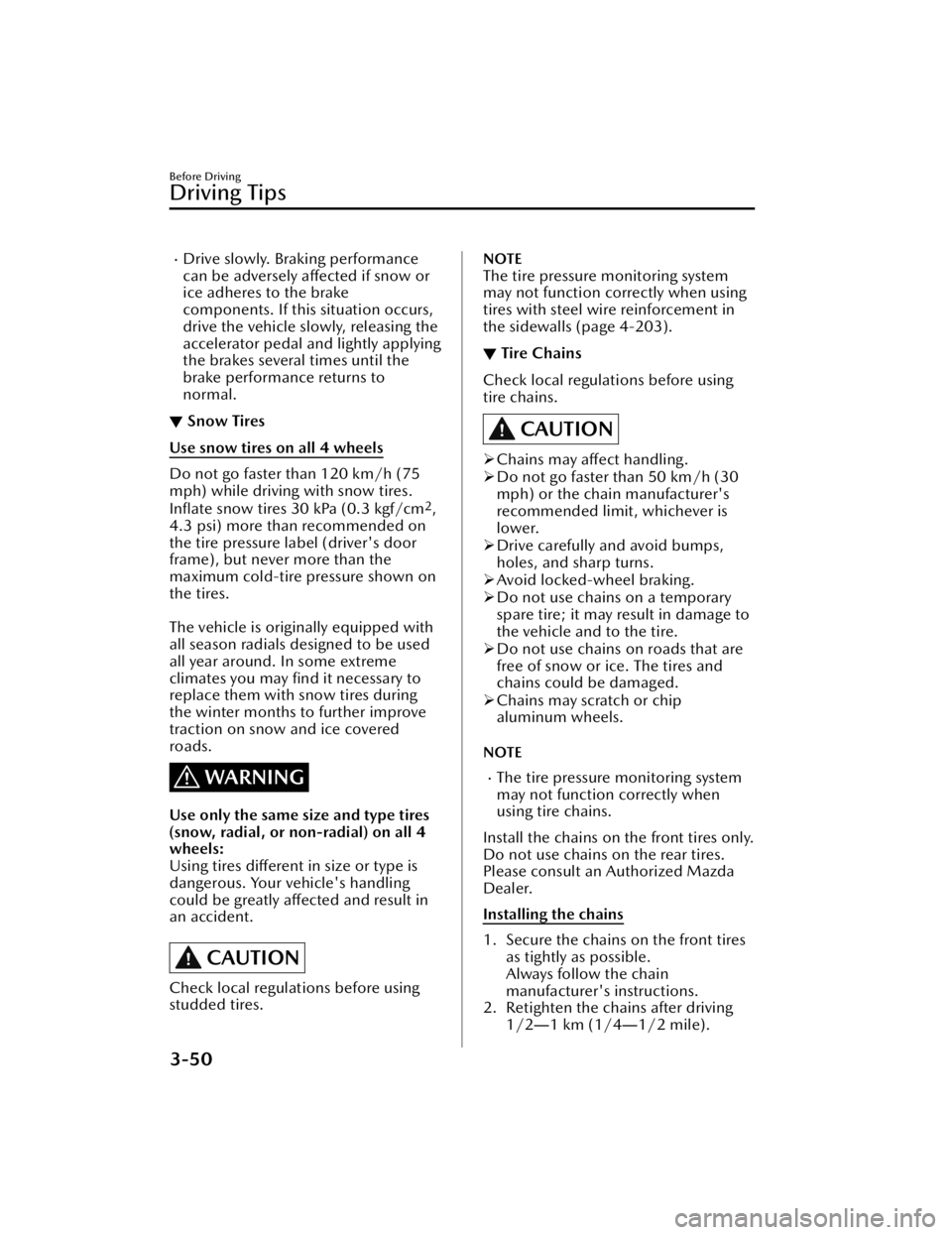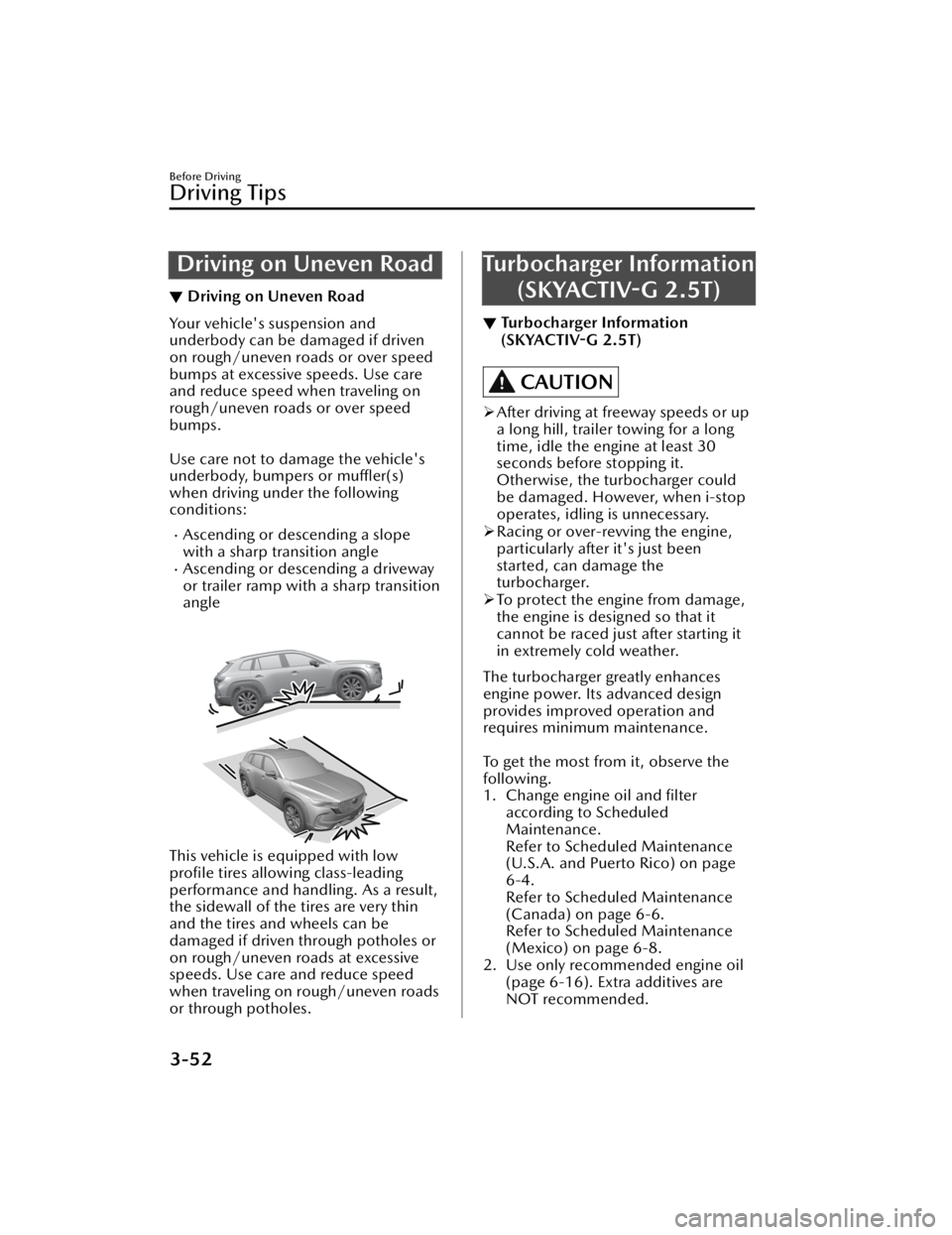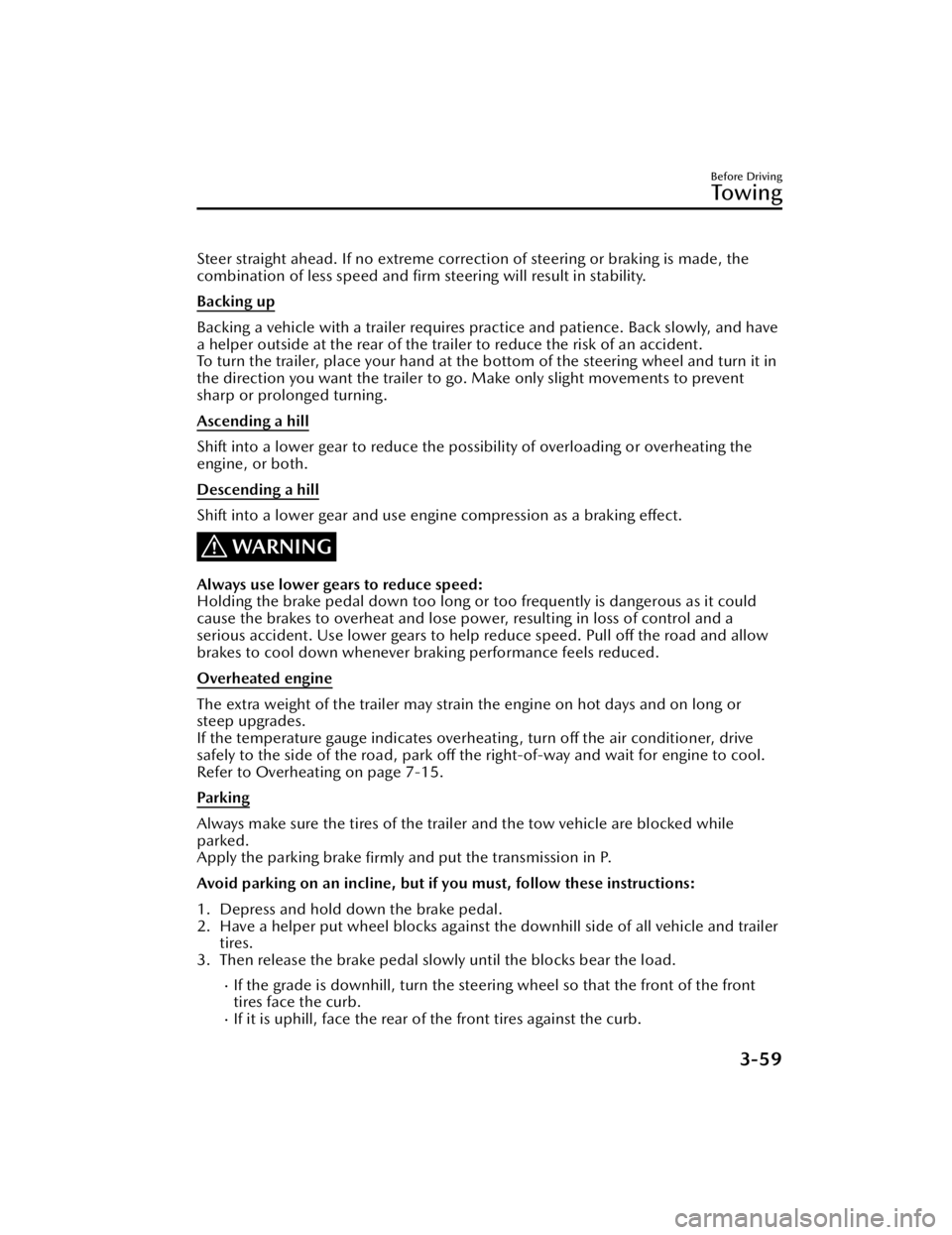wheel MAZDA MODEL CX-50 2023 Owner's Manual
[x] Cancel search | Manufacturer: MAZDA, Model Year: 2023, Model line: MODEL CX-50, Model: MAZDA MODEL CX-50 2023Pages: 583, PDF Size: 85.63 MB
Page 138 of 583

Rocking the Vehicle
▼Rocking the Vehicle
WARNING
Do not spin the wheels at more than
56 km/h (35 mph), and do not allow
anyone to stand behind a wheel when
pushing the vehicle:
When the vehicle is stuck, spinning the
wheels at high speed is dangerous. The
spinning tire could overheat and
explode. This could cause serious
injuries.
CAUTION
Too much rocking may cause engine
overheating , transmission failure, and
tire damage.
If you must rock the vehicle to free it
from snow, sand or mud, depress the
accelerator slightly and slowly move
the selector lever from D to R position.
Winter Driving
▼Winter Driving
Carry emergency gear, including tire
chains, window scraper,
flares, a small
shovel, jumper cables, and a small bag
of sand or salt.
Ask an Authorized Mazda Dealer to
check the following:
Have the proper ratio of antifreeze in
the radiator.
Refer to Engine Coolant on page
6-19.
Inspect the battery and its cables.
Cold reduces battery capacity.
Use an engine oil appropriate for the
lowest ambient temperatures that
the vehicle will be driven in (page
6-16).
Inspect the ignition system for
damage and loose connections.
Use washer fluid made with
antifreeze ―but do not use engine
coolant antifreeze for washer fluid
(page 6-21).
NOTE
Remove snow before driving. Snow
left on the windshield is dangerous
as it could obstruct vision.
Do not apply excessive force to a
window scraper when removing ice
or frozen snow on the mirror glass
and windshield.
Never use warm or hot water for
removing snow or ice from windows
and mirrors as it could result in the
glass cracking.
Before Driving
Driving Tips
3-49
CX-50_8KB8-EA-22A_Edition2_new 2022-1-6 14:55:18
Page 139 of 583

Drive slowly. Braking performance
can be adversely affected if snow or
ice adheres to the brake
components. If this situation occurs,
drive the vehicle slowly, releasing the
accelerator pedal and lightly applying
the brakes several times until the
brake performance returns to
normal.
▼ Snow Tires
Use snow tires on all 4 wheels
Do not go faster than 120 km/h (75
mph) while driving with snow tires.
Inflate
snow tires 30 kPa (0.3 kgf/cm
2,
4.3 psi) more than recommended on
the tire pressure label (driver's door
frame), but never more than the
maximum cold-tire pressure shown on
the tires.
The vehicle is orig inally equipped with
all season radials designed to be used
all year around. In some extreme
climates you may find it necessary to
replace them with snow tires during
the winter months to further improve
traction on snow and ice covered
roads.
WARNING
Use only the same size and type tires
(snow, radial, or non-radial) on all 4
wheels:
Using tires different in size or type is
dangerous. Your vehicle's handling
could be greatly affected and result in
an accident.
CAUTION
Check local regulations before using
studded tires.
NOTE
The tire pressure monitoring system
may not function correctly when using
tires with steel wire reinforcement in
the sidewalls (page 4-203).
▼ Tire Chains
Check local regulations before using
tire chains.
CAUTION
Chains may affect handling.
Do not go faster than 50 km/h (30
mph) or the chain manufacturer's
recommended limit, whichever is
lower.
Drive carefully and avoid bumps,
holes, and sharp turns.
Avoid locked-wheel braking.
Do not use chains on a temporary
spare tire; it may result in damage to
the vehicle and to the tire.
Do not use chains on roads that are
free of snow or ice. The tires and
chains could be damaged.
Chains may scratch or chip
aluminum wheels.
NOTE
The tire pressure monitoring system
may not function correctly when
using tire chains.
Install the chains on the front tires only.
Do not use chains on the rear tires.
Please consult an Authorized Mazda
Dealer.
Installing the chains
1. Secure the chains on the front tires as tightly as possible.
Always follow the chain
manufacturer's instructions.
2. Retighten the chains after driving 1/2 ―1 km (1/4 ―1/2 mile).
Before Driving
Driving Tips
3-50
CX-50_8KB8-EA-22A_Edition2_new 2022-1-6 14:55:18
Page 141 of 583

Driving on Uneven Road
▼Driving on Uneven Road
Your vehicle's suspension and
underbody can be damaged if driven
on rough/uneven roads or over speed
bumps at excessive speeds. Use care
and reduce speed when traveling on
rough/uneven roads or over speed
bumps.
Use care not to damage the vehicle's
underbody, bumpers or
muffler(s)
when driving under the following
conditions:
Ascending or descending a slope
with a sharp transition angle
Ascending or descending a driveway
or trailer ramp with a sharp transition
angle
This vehicle is equipped with low
profile tires allowing class-leading
performance and handling. As a result,
the sidewall of the tires are very thin
and the tires and wheels can be
damaged if driven through potholes or
on rough/uneven roads at excessive
speeds. Use care and reduce speed
when traveling on rough/uneven roads
or through potholes.
Turbocharger Information (SKYACTIV-G 2.5T)
▼Turbocharger Information
(SKYACTIV-G
2.5T)
CAUTION
After driving at freeway speeds or up
a long hill, trailer towing for a long
time, idle the engine at least 30
seconds before stopping it.
Otherwise, the turbocharger could
be damaged. However, when i-stop
operates, idling is unnecessary.
Racing or over-revving the engine,
particularly after it's just been
started, can damage the
turbocharger.
To protect the engine from damage,
the engine is designed so that it
cannot be raced just after starting it
in extremely cold weather.
The turbocharger greatly enhances
engine power. Its advanced design
provides improved operation and
requires minimum maintenance.
To get the most from it, observe the
following.
1. Change engine oil and filter according to Scheduled
Maintenance.
Refer to Scheduled Maintenance
(U.S.A. and Puerto Rico) on page
6-4.
Refer to Scheduled Maintenance
(Canada) on page 6-6.
Refer to Scheduled Maintenance
(Mexico) on page 6-8.
2. Use only recommended engine oil (page 6-16). Extra additives are
NOT recommended.
Before Driving
Driving Tips
3-52
CX-50_8KB8-EA-22A_Edition2_new 2022-1-6 14:55:18
Page 142 of 583

Trailer Towing (U.S.A. and Canada)
▼Trailer Towing (U.S.A. and Canada)
Your Mazda was designed and built primarily to carry passengers and cargo.
If you tow a trailer, follow these instructions because driver and passenger safety
depends on proper equipment and safe driving habits. Towing a trailer will
affect
handling, braking , durability, performance, and fuel economy.
Never overload your vehicle or trailer. Co nsult an Authorized Mazda Dealer if you
need further details.
CAUTION
Do not tow a trailer during the first 1,000 km (600 miles) of your new Mazda. If you
do, you may damage the engine, transmission, differential, wheel bearings, and
other power-train components.
NOTE
When towing, use of gasoline with a octane rating of 91 or higher is
recommended.
Your vehicle is equipped with a Mazda intelligent Drive Select (Mi-Drive) towing
mode* which enhances vehicle stab ility when towing a trailer.
Refer to Mazda intelligent Drive Select (Mi-Drive) (AWD) on page 4-83.
When towing a trailer, do not use the following safety systems (If a Mazda genuine
trailer hitch is used, these systems are automatically turned off):
Blind Spot Monitoring (BSM)Rear Cross Traffic Alert (RCTA)Smart Brake Support [Rearward detection function]Smart Brake Support [Rear crossing]Parking Sensor System (Rear)Blind Spot Assist of Emergency Lane Keeping (ELK)
▼ We igh t L imits
TTW and GCWR
The total trailer weight (TTW), gross comb
ination weight rating (GCWR), gross axle
weight rating (GAWR), trailer load, and trailer tongue load must be within the
prescribed limits.
The total trailer weight (TTW) is the sum of the weights of the trailer load (trailer
weight plus cargo), trailer hitch, 2 passengers, and vehicle load (baggage, food,
camp gear, etc.). Never allow the total trailer weight (TTW) to exceed
specifications in the Trailer Towing-Load Table.
The maximum GCWR is the combination weight of the trailer and load plus the
towing vehicle (including trailer hitch, ve hicle passengers, and load). It must not
exceed the specifications in the load table.
Before Driving
Towing
*Some models.3-53
CX-50_8KB8-EA-22A_Edition2_new 2022-1-6 14:55:18
Page 147 of 583

▼Trailer Towing Tips
Verify that your Mazda maintains a near-normal attitude when a loaded or
unloaded trailer is connected. Do not drive if it has an abnormal front-up or
front-down position. Inspect for incorrec
t tongue load, worn suspension parts,
and trailer overloading.
Make sure the trailer is properly loaded and the cargo is secure to prevent it from
shifting.
Make sure the mirrors conform to all govern ment regulations. If they do not, install
required rear view mirrors appropriate for towing purposes.
The three main causes of vehicle-trailer accidents are driver error, excessive speed,
and improper trailer loading.
Before driving
Have your cooling and braking system checked by an Authorized Mazda Dealer.Before starting out, inspect the operation of all vehicle and trailer lights and all
vehicle-to-trailer connections. Stop and re-inspect all lights and connections after
driving a short distance.
Driving
Your Mazda will handle differently with a trailer in tow, so practice turning,
backing, and stopping in a traffic-free area.
Take time to get accustomed to the extra weight and length.Allow more room between your vehicle and the one in front because braking
distance increases with a trailer. For each 16 km/h (10 mph) of speed, allow at
least one vehicle and trailer length between your Mazda and the vehicle ahead.
Avoid jerky starts or sudden acceleration.Avoid sudden braking. It may cause loss of control and result in jackknifing ,
especially so on wet or slippery roads.
Shift the selector lever to the D position when towing a trailer in hilly terrain or
when heavily loaded.
The D position will allow operating the vehicle without frequent shifting.
Lane changes and turning
Avoid quick lane changes, su dden turns, and tight turns. Slow down before turning
to avoid the need of sudden braking.
A turning trailer will make a tighter arc than the tow vehicle. Compensate with turns
that are larger than normal.
Pa s s i n g
Plan well ahead to pass other vehicles, and provide plenty of room before changing
lanes. Crosswinds from passing vehicles, especially larger ones, and the effects of
rough roads will affect handling.
If swaying occurs, firmly grip the steering wheel and reduce speed immediately, but
gradually.
Before Driving
To w i n g
3-58
CX-50_8KB8-EA-22A_Edition2_new 2022-1-6 14:55:18
Page 148 of 583

Steer straight ahead. If no extreme correction of steering or braking is made, the
combination of less speed and firm steering will result in stability.
Backing up
Backing a vehicle with a trailer requires practice and patience. Back slowly, and have
a helper outside at the rear of the trai ler to reduce the risk of an accident.
To turn the trailer, place your hand at the bottom of the steering wheel and turn it in
the direction you want the trailer to go. Make only slight movements to prevent
sharp or prolonged turning.
Ascending a hill
Shift into a lower gear to reduce the possibility of overloading or overheating the
engine, or both.
Descending a hill
Shift into a lower gear and use engine compression as a braking effect.
WARNING
Always use lower gears to reduce speed:
Holding the brake pedal down too long or too frequently is dangerous as it could
cause the brakes to overheat and lose power, resulting in loss of control and a
serious accident. Use lower gears to help reduce speed. Pull off the road and allow
brakes to cool down whenever braking performance feels reduced.
Overheated engine
The extra weight of the trailer may strain the engine on hot days and on long or
steep upgrades.
If the temperature gauge indicates overheating, turn off the air conditioner, drive
safely to the side of the road, park off the right-of-way and wait for engine to cool.
Refer to Overheating on page 7-15.
Pa r k i n g
Always make sure the tires of the trailer and the tow vehicle are blocked while
parked.
Apply the parking brake firmly and put the transmission in P.
Avoid parking on an incline, but if you must, follow these instructions:
1. Depress and hold down the brake pedal.
2. Have a helper put wheel blocks against the downhill side of all vehicle and trailer tires.
3. Then release the brake pedal slowly until the blocks bear the load.
If the grade is downhill, turn the steering wheel so that the front of the front
tires face the curb.
If it is uphill, face the rear of the front tires against the curb.
Before Driving
Towing
3-59
CX-50_8KB8-EA-22A_Edition2_new 2022-1-6 14:55:18
Page 149 of 583

4. Firmly apply the parking brake.
5. Shift the transmission into P, and stop the engine.
To restart after parking on an incline:
1. With the transmission in P, start the engine. (Be sure to depress and hold thebrake pedal.)
2. Shift into gear.
3. Release the parking brake (also the foot brake) and pull away from the wheel blocks. Stop; apply the parking brake and shift into P.
4. Have a helper retrieve the wheel blocks.
Fuel consumption
Trailer towing causes higher fuel consumption.
Maintenance
If you tow a trailer frequently, have your vehicle serviced as shown in Scheduled
Maintenance (page 6-4).
Before Driving
To w i n g
3-60
CX-50_8KB8-EA-22A_Edition2_new 2022-1-6 14:55:18
Page 150 of 583

Recreational Towing
▼Recreational Towing
An example of "recreational towing" is
towing your vehicle behind a
motorhome.
The transmission is not designed for
towing this vehicle on all 4 wheels.
When doing recreational towing refer
to "Towing Description" (page 7-17)
and "Tiedown Hooks" (page 7-18)
and carefully follow the instructions.
Before Driving
Towing
3-61
CX-50_8KB8-EA-22A_Edition2_new
2022-1-6 14:55:18
Page 164 of 583

While vehicle is stopped
The selector lever is in the D or M
position (not in second gear fixed
mode).
The automatic transmission fluid
has warmed up sufficiently.
The automatic transmission fluid
temperature is not abnormally
high.
The steering wheel is almost in the
straight-ahead position (idling may
not stop even with the steering
wheel in the straight-ahead
position if force is applied to the
steering wheel. Release the force
applied to the steering wheel to
stop engine idling).
The vehicle is stopped by
depressing the brake pedal.
The vehicle is not on a steep slope.The vehicle is not stopped
suddenly.
While driving
The selector lever is in the D or M
position (not in second gear fixed
mode).
While drivingThe vehicle is driven at a vehicle
speed of about 40 km/h (25 mph)
or faster after engine idling stops
while driving.
The vehicle is not driven in sport
mode.
The automatic transmission fluid
has warmed up sufficiently.
The automatic transmission fluid
temperature is not abnormally
high.
The steering wheel is almost in the
straight-ahead position (idling may
not stop even with the steering
wheel in the straight-ahead
position if force is applied to the
steering wheel. Release the force
applied to the steering wheel to
stop engine idling).
The vehicle is stopped by
depressing the brake pedal.
The vehicle is not driven on a
slope.
The vehicle is not stopped
suddenly.
NOTE
Under the following conditions, a
period of time is required to stop
engine idling
The battery power is depleted for
some reason such as the vehicle has
not been driven for a long period.
The ambient temperature is high or
low.
After the battery terminals are
disconnected for some reason such
as for battery replacement.
Engine-stop period is short or time
until next engine idle stop is long
The ambient temperature is high or
low.
The battery power is depleted.Power consumption by the vehicle's
electrical parts is high.
Engine restarts automatically while
engine idling is stopped
Under the following conditions, the
engine restarts automatically.
The i-stop OFF switch is pressed until
the beep sounds.
The air conditioner is operated with
the airflow mode in the
position.The temperature setting dial of the
air conditioner is in the maximum
heating or maximum cooling (A/C
ON) position.
When Driving
Start/Stop Engine
4-13
CX-50_8KB8-EA-22A_Edition2_new 2022-1-6 14:55:18
Page 165 of 583

(Automatic climate control system)
The cabin temperature is largelydifferent from the set temperature of
the air conditioner.
The brakes are released slightly on a
slope and the vehicle begins to
move.
Two minutes have elapsed since the
idling was stopped.
The battery power is depleted.The hood is opened.The driver's seat belt is unfastened
and the driver's door is opened.
Engine idling is stopped while the
vehicle is stopped
The accelerator pedal is depressed
with the selector lever in the D or
M (not in second gear fixed mode)
position.
The selector lever is shifted to the R
position.
The selector lever is shifted from N
or P position to D or M (not in
second gear fixed mode) position.
The steering wheel is operated
with the selector lever in the D or
M (not in second gear fixed mode)
position.
The selector lever is in the M
position and the second gear fixed
mode is selected.
With the selector lever in the P or
N position, or the D/M range, the
driver's seat belt is unfastened, the
driver's door is opened, or the
hood is opened.
The steering wheel is operated.Engine idling is stopped while
driving
The selector lever is in a position
other than the D position.
The accelerator pedal is depressed.Sport mode is selected.The steering wheel is operated.
The shift lever is shifted to the R
position.
Selector lever is operated while
engine idling is stopped
If the selector lever is shifted from D or
M (not in second gear fixed mode)
position to N or P position while
engine idling is stopped, the engine
does not restart even when the brake
pedal is released. The engine will
restart if the brake pedal is depressed
again or the selector lever is shifted to
the D, M (not in second gear fixed
mode), or R position. (For the
purposes of safety, always keep the
brake pedal depressed when shifting
the selector lever.)
If the selector lever is shifted from the
D or M (not in second gear fixed
mode) to the N or P position, and the
driver's seat belt is unfastened or the
driver's door is opened, the engine
restarts.
Battery terminals have been
disconnected
Engine idling may not stop right after
the battery terminals have been
disconnected. In addition, if the
battery is replaced, the i-stop functions
must be verified. Consult an
Authorized Mazda Dealer.
When Driving
Start/Stop Engine
4-14
CX-50_8KB8-EA-22A_Edition2_new 2022-1-6 14:55:18